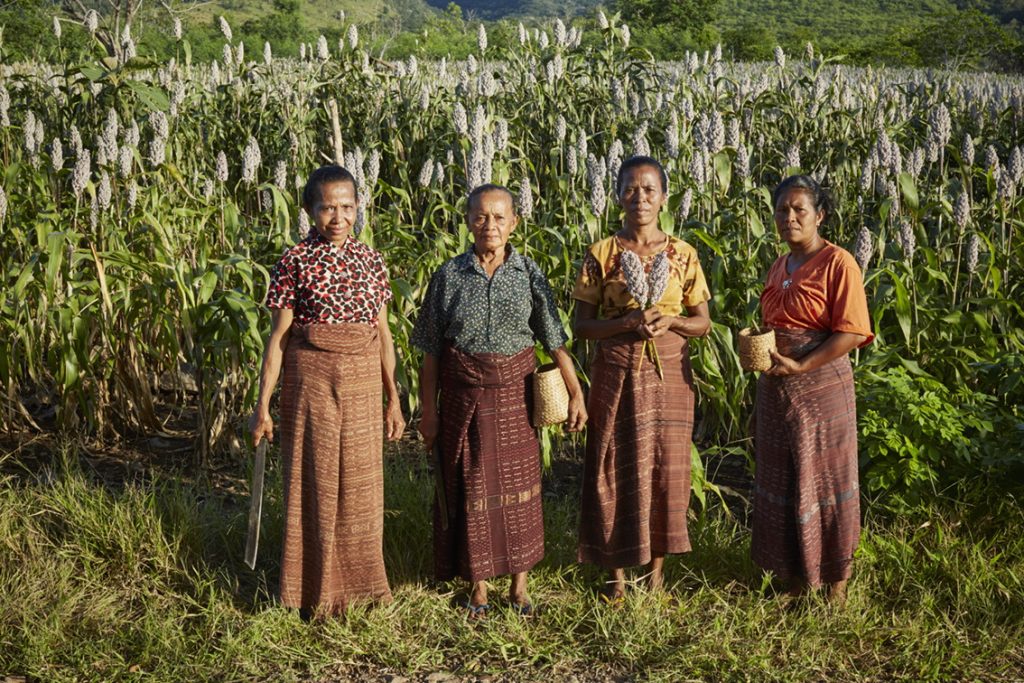For Indigenous Buryat nomadic herders in the Russian part of Central Asia, life would be far more difficult without the Buryat cow. The disappearance of this emblematic animal would mean the violation of their rights and the degradation of their landscape and their lives. Able to thrive in brutal Siberian winters, the animal is central to their diet and sacred rituals. Its migratory grazing patterns return organic matter to the soil, enriching the carbon-sequestering capacity of steppe pastures.

Indigenous cattle are adapted to the long winters of Buryatia, conditions which are far too harsh for most introduced breeds of livestock. Photo credit: Alexandr Khamaganov
Much of the world does not know how close the Buryat cow has come to extinction. For decades, misguided Soviet policies favoured allegedly higher-yielding Western breeds over its shaggy cousin. Less hardy, the newly introduced species required expensive heating, fodder, and medicines, literally gnawing away the Buryats’ livelihoods and landscape. Now, Buryat communities are joining forces with local researchers and grassroots organizations to revive the native cow, restoring their food system and depleted ecosystems, and reclaiming their rights, livelihoods, and identity.
This recovery was made possible in part thanks to philanthropic organizations like the Agroecology Fund and Global Greengrants Fund which fund community-led change processes and rights-based environmental justice.
In 2021, these two funders partnered up, recognizing how critical it is to support agroecology-based food systems as a key climate solution which opens up enormous opportunities for movement-building. The funds also provide models for how to fund grassroots climate solutions, and how to fund them well.
Together, the Agroecology Fund and Global Greengrants Fund have reaffirmed their commitment to uphold people’s rights to land, water, and natural resources, as well as the sustainable management of those resources. Sharing a common approach and commitment to agroecology; farming with nature, rather than using nature – they aim to further grassroots solutions to climate change, biodiversity loss, and food insecurity.
Investing through a rights-based lens
Increasing the flow of funds to critical Indigenous and grassroots stewards of ecosystems and natural resources – like the Buryat people – is a long overdue shift in philanthropy.
The dangers of relying on fossil fuel-based pesticides, imported fertilizers and other inputs in this time of climate instability and political conflict have never been clearer. From the steppes of Central Asia to rainforests in the Amazon, the Philippines, and West Africa, unchecked extraction is threatening once abundant ecosystems. Oil, logging, and agri-business companies continue to degrade soils, water, and biodiversity by practicing deforestation, mono-cultivation, and pesticide poisoning. Lax or biased policies encourage land grabbing and violence against local communities and Indigenous peoples. All these industrial agriculture activities are responsible for over a quarter of greenhouse gas emissions.
Agroecology – the application of ecological concepts and principles in farming – considers the relationships between all the plant, animal, and human elements in a system. When kept in balance, these relationships establish healthy and thriving ecosystems that feed all living things in them
In order to reverse the crises that threaten the planet’s ability to feed a growing population, and bring about the systemic change outlined in the latest report from the Intergovernmental Panel on Climate Change, humans must restore and maintain the balance of life in ecosystems through practices that are deeply rooted in millennia-old Indigenous knowledge – in the case of food and farming systems, through agroecology. This approach is something called for by not only the IPCC, but grassroots networks have advocated for at the recent Climate Conference of Parties (COP27) in Egypt and the Biodiversity COP15 in Canada – two of the largest annual global gatherings centred on tackling the climate and biodiversity crises.
Agroecology – the application of ecological concepts and principles in farming – considers the relationships between all the plant, animal, and human elements in a system. When kept in balance, these relationships establish healthy and thriving ecosystems that feed all living things in them. Such systems contribute to both climate mitigation and adaptation. In its recent report, Soil to Sky: Climate Solutions That Transform, the CLIMA Fund, a funder collaborative that Global Greengrants is a member of, outlines that agroecology has the potential to reduce 490 gigatons of carbon dioxide emissions by 2050 – which is roughly equivalent to total estimated emissions from China between now and 2050.
Allison Davis, Director of Programs and Learning at Global Greengrants Fund, puts it this way: ‘The real solutions to climate change will come from frontline communities resisting untenable fossil fuel development, the work of traditional farmers who practice soil conservation, the rights of Indigenous Peoples to defend their forests, and ever-resilient communities with diverse economies and networks.’
Despite how critical agroecology is to avert the climate crisis, the majority of international funds aimed at addressing food insecurity, global temperature rises, and biodiversity loss, are still diverted to unsustainable approaches – otherwise known as false solutions – that exacerbate the problems they purport to solve. For example, 15 years and billions of dollars after its establishment, the Alliance for a Green Revolution in Africa (AGRA) initiative – designed largely around proprietary Western technologies – has failed to increase incomes and food security for nine million smallholder farmers, while degrading their natural resource base.
Organizations like the Agroecology Fund and Global Greengrants Fund, on the other hand, are channelling funding toward the establishment of more sustainable food systems that uphold environmental justice and human rights – and these more sustainable solutions are having deep impacts.
In Ogoniland, Nigeria, for example, Shell Oil has contaminated the local waterways and ecosystems in the Niger Delta with spilled crude. This has devastated mangrove forests and the fish populations that local communities depend on. Rather than wait for government action to resolve this existential threat, local women have been actively working to restore their natural food system with support from Global Greengrants Fund. They have been developing a native tree nursery while leading efforts to clean the water from oil pollution.
The Agroecology Fund and Global Greengrants Fund are championing similar solutions around the world, such as returning traditional crops in Brazil and Palestine, planting sorghum in Indonesia, and producing local stock cubes in Senegal.
This movement-centred, grassroots approach supports Indigenous Peoples and rural smallholder farmers – those responsible for feeding most of the world and, tragically, those most vulnerable to human-made climate change. It is pivotal that climate funders stand with these movements.
Decolonizing philanthropy
How philanthropy makes funding decisions and engages with partners cannot be an afterthought in funding agroecology. Too much of philanthropy maintains a top-down relationship with grantee partners – an approach that limits the autonomy and flexibility of grantees, retaining power in the hands of Global North donors and diluting the core values of decentralization and collectivity that are key to effective agroecological solutions.
The Agroecology Fund-Global Greengrants Fund partnership mirrors the two organizations’ shared approach to decentralized grantmaking and serves as a model for how to fund agroecology in a way that enhances rather than hinders its impact. Grantmaking decisions are informed by independent advisors and experts across five continents, who have first-hand knowledge of local movements and their contexts. Meanwhile, grantees have the ultimate say on how money is spent. This favours local solutions in greater harmony with agroecological approaches in a given territory.
‘For us, our network of global advisors are a kind of participatory guarantee system,’ asserts Angela Cordeiro, Co-Director of the Agroecology Fund. ‘Based on their deep knowledge and extensive grassroots networks, they guide us in offering resources to strengthen complex movements.’
The recent establishment of region-centric ‘sister’ funds, led by local grassroots partners in the Global South, underscores this commitment to decentralization and serves as a further example of funding that more effectively supports agroecology. For instance, building on insights from its grantee partners and with support from the W.K. Kellogg Foundation, the Agroecology Fund, has set up the Fondo Agroecológico Península de Yucatán – FAPY (Agroecology Fund of the Yucatán Peninsula). With its own – largely Mayan – advisors from local communities, FAPY supports grassroots projects that strengthen agroecological production, deepen locally-led research and learning, improve market access, and build a more just and climate-resilient food system centred around Mayan rural communities. Global Greengrants is also committed to establishing, partnering, and supporting regional and national socio-environmental funds, including Fondo Tierra Viva in Central America, Fondo Acción Solidaria in Mexico, Fondo Sociambiental Casa, in South America, and Samdhana Institute in South East Asia. Greengrants is also part of a growing community of funders who together are mobilizing philanthropy to invest in grassroots groups creating sustainable and effective solutions to our global climate crisis, including through their work with the funder collaborative CLIMA Fund.
The need to support grassroots organizations that protect human rights and nature has never been more urgent. We remain committed to decolonizing our grantmaking systems through participatory, decentralized, and locally-led philanthropic approaches that shift power back to social movements, thereby ensuring they have more say in determining the health of their food, water, and resources, and emerge as effective global change agents. Holistic approaches to community management of natural resources with agroecological food systems at their core point us toward sustainable food production that does not pit agriculture against nature.
Directing resources to frontline grassroots networks advancing effective and equitable food and climate solutions safeguards and amplifies local people’s autonomy and food sovereignty. We all benefit from their deep knowledge and experience as the world urgently searches for creative solutions to multiple crises.
Daniel Moss is Co-Director of the Agroecology Fund, and Laura García is President and CEO of Global Greengrants Fund.





Comments (0)
This is very much interesting and inspiring work. Together we can build a sustainable agriculture, promote and strengthen food security and environmental protection.